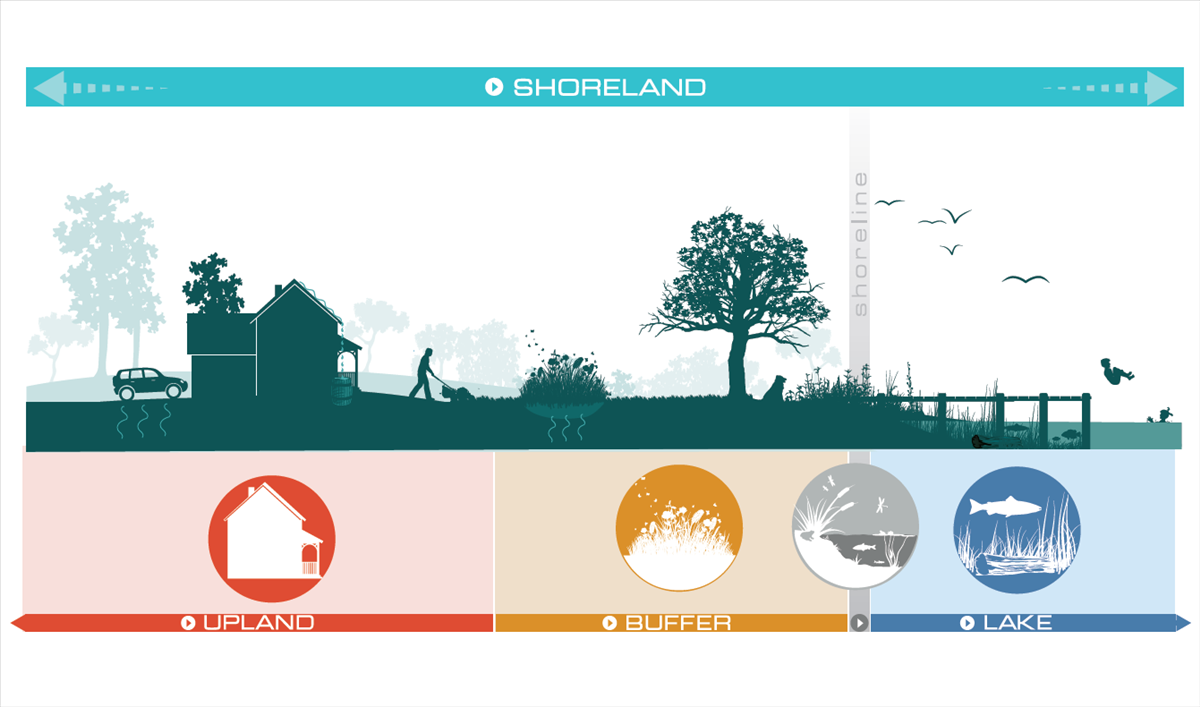Understanding the Four Zones
Healthy shoreland property management is important to protect the lake and your own property. How a property is managed is important because decisions in all areas can affect the lake.
The MI Department of Natural Resources Conservation Guidelines for Michigan Lakes recommends:
-
Development/alteration of any habitat component should not exceed 25%. Development of 25% or less of the lake provides reasonable owner access and use and also preserves lake health.
-
Properties should maintain naturally sloped shorelines, have a 35 foot vegetated buffer and use 25% or less of the shoreline for access and use of the lake.
-
Native aquatic plants should not be removed or reduced in lakes beyond what is needed for boating lanes.
To evaluate a property and specific management practices important to each area this program has divided the shoreland property into four different zones: Upland, Buffer, Shoreline, Lake.

The Four Zones
The four zones of a shoreland property do not have clear and distinct lines of separation. The size and shape of these vary and depend upon many factors including but not limited to: lot size, soil type, slope of the land, the shape and type of the lake, vegetation type and water level fluctuations. Some general descriptions and graphics of the zones are provided below to help you use your best judgement based on your property characteristics.
-
Upland Zone: This zone sets back from the lake. It starts where the Buffer Zone ends 35 feet from the top of the shoreline bank. This zone typically includes the house, driveway and garage. This is also where the majority of stormwater runoff will be generated due to the amount of hard surfaces.
-
Buffer Zone: This zone is immediately next to the lake. It begins at the top of the bank (edge of the Shoreline Zone) and is the first 35 feet of the lake front property. This part of the shoreland property is very important in protecting the lake ecosystem and maintaining a stable shoreline.
-
Shoreline Zone: This is the transition zone from water to land. There is not an exact line between the land and aquatic zones. It begins at the top of the bank and extends to the land-water interface. The shape and size will vary greatly depending on the type of lake, soils and other factors. It is important to maintain as natural of a shoreline zone as possible.
-
Lake Zone: This is the nearshore area or "littoral zone" of the lake. It is the shallow part of the lake where there is enough light reaching the bottom to allow aquatic plants to grow. The size of this area will vary depending on multiple factors including the lake size, shape of the bottom of the lake (bathymetry) and water levels. Some will have very large littoral zones with a lot of aquatic plants and some will have very small littoral zones with few aquatic plants. A healthy littoral zone provides food, shelter, shade and areas to raise young for fish and wildlife. You can still have a swim area but we ask that you share it with the fish and wildlife that need a healthy littoral zone for survival!

